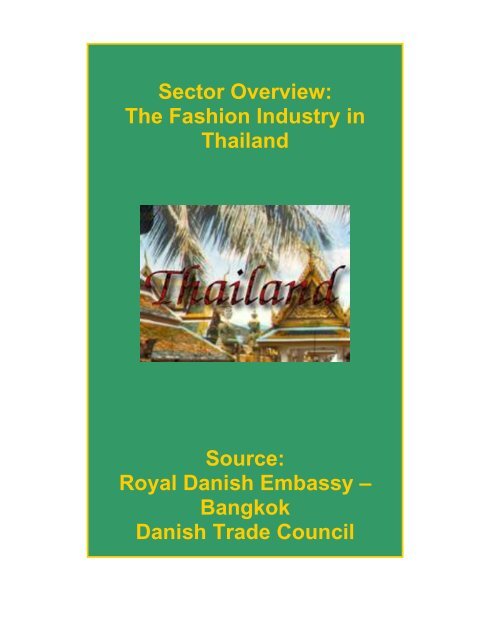Bangkok Danish Trade Council - Fibre2fashion
Bangkok Danish Trade Council - Fibre2fashion
Bangkok Danish Trade Council - Fibre2fashion
You also want an ePaper? Increase the reach of your titles
YUMPU automatically turns print PDFs into web optimized ePapers that Google loves.
Sector Overview:<br />
The Fashion Industry in<br />
Thailand<br />
Source:<br />
Royal <strong>Danish</strong> Embassy –<br />
<strong>Bangkok</strong><br />
<strong>Danish</strong> <strong>Trade</strong> <strong>Council</strong>
Sector overview: The fashion industry in Thailand<br />
Introduction<br />
Source: Royal <strong>Danish</strong> Embassy – <strong>Bangkok</strong> <strong>Danish</strong> <strong>Trade</strong> <strong>Council</strong><br />
The fast-growing Thai fashion industry, encompassing leather, jewellery and garment industries, contributes<br />
to <strong>Bangkok</strong>’s creative and energetic ambiance. However, fashion is still a young industry in Thailand<br />
compared to European fashion houses, as its first brands appeared only some 25 years ago. Nevertheless,<br />
in terms of market range, the Thai fashion industry has grown to cover near the whole prêt-á-porter sector:<br />
women’s, men’s, and children’s fashions are all well-represented in <strong>Bangkok</strong>’s shop windows.<br />
Fashion in this report will focus on the garment, leather based and gems and jewellery industry.<br />
Thailand has strong traditions for high-quality fabrics such as Thai silk. Today, the industry has an important<br />
contributing role to the country’s economy, accounting for approximately 17 percent of total GDP.<br />
The government has taken action to further strengthen this industry by setting up the “<strong>Bangkok</strong> Fashion<br />
City” project launched in February 2004, which serves to turn <strong>Bangkok</strong> into a fashion hub in the South East<br />
Asia region and into a world fashion centre by the year 2012. The cabinet has approved a budget of THB 1.8<br />
billion (DKK 282 million) plus THB 487.9 million (DKK 76.5 million) from the private sector for the project in<br />
2005. Its goals are to promote all aspects of Thailand's fashion trade covering textiles, garments, jewellery<br />
and ornaments, footwear and leather industries on a grand scale and to establish the image of <strong>Bangkok</strong> as a<br />
centre of fashion designs.<br />
Full liberalization in textile quotas under World <strong>Trade</strong> Organization (WTO) commitments that came into effect<br />
January 1, 2005, has caused tougher competition between WTO member states in global textile markets<br />
and Thailand is becoming less competitive against cheap labour countries such as China, Indonesia, India,<br />
Pakistan, and Vietnam. Thai manufacturers should manufacture higher quality products in order to compete<br />
with high quality product countries such as Hong Kong, Korea, and Taiwan. Furthermore improvement of<br />
logistics and supply chain systems is a must in order to gain better efficiency and promptness in the industry.<br />
2: Market indicators<br />
2.1: Market structure<br />
The far most central sector in the fashion industry is textile. It consists of six different industries (the<br />
synthetic fibre industry, the spinning industry, the weaving industry, the knitting industry, the garment<br />
industry and the industry of bleaching, dying, and finishing) with the garment industry being the largest in<br />
terms of production output.<br />
The Thai textile industry is pursuing high quality, value-added strategy to succeed in the quota-free,<br />
competitive environment. The quality of the fabrics in Thailand is generally high and continuously improving.<br />
The silk quality is especially good, and Thailand is particularly strong in design such as Jim Thompson silk.<br />
The government-sponsored programs to advance the Thai fashion industry beyond OEM-based production<br />
to higher value-added design and brand development work are preparing the industry further to compete in<br />
the Post-Multifibre Agreement (MFA) environment.<br />
To be prepared for the MFA the textile and garment industry has invested more than US$45(DKK 268)<br />
million in imported machinery over four years for fibre manufacturing, spinning, weaving, dyeing, printing and<br />
finishing.<br />
The numbers below show the increase in imports and exports from Thailand of textile and clothing. The<br />
development should be considered in the context of Chinas rapid growth within the last years particularly<br />
within textile and clothing industry.
The major import countries within garments is China, Hong Kong, Italy, Spain, Japan, within fabrics; China,<br />
Taiwan, Japan, Hong Kong, South Korea and within fibre import it is Australia, USA, India, Japan and Mali.<br />
2.2: Market size<br />
The fashion industry is a major contributor to the Thai economy, accounting for approximately 17 percent of<br />
total GDP. It is the largest manufacturing industry in Thailand, with more than 4,500 factories employing<br />
more than one million people, roughly 20 % of total employment in manufacturing.<br />
In addition, with annual exports of more than US$ 6 billion (DKK 35.68 billion) per year, textiles and<br />
garments rank as one of the nations leading export industry, with garment exports accounting for 60 % of<br />
total export. In 2003 Thailand ranked as the 13 th largest exporter of garments, with a 2 % share of the global<br />
export market.<br />
Analysts expect the industry to enjoy continuous growth, despite of the rising fuel prices, which have<br />
affected production cost. Additionally most producers and exporters work on gradually improving product<br />
quality in order to meet the requirements of the international market.<br />
As much as 50% of the earnings from Thailand’s fashion houses come from tourists, who have been<br />
surprised by the Thai fashion industry with its abundance and small fashion houses. The former<br />
governments focus on this industry has helped it grow into twice as many local brands from the total two<br />
decades ago, as well as penetration on the international market. Five Thai design firms were in 2005 invited<br />
to join the ‘White’ trade fair, an annual international fashion showcase held in Milan.<br />
Furthermore Thais are very fashion conscious which make a demanding home market. Still the 10 million<br />
tourists arriving in Thailand every year helps spark new ideas and provide a ready supply of customers for<br />
Thailand’s fashion industry. The ancient appreciation of beauty, a modern sense of style and decades of<br />
production experience make Thailand an obvious location for foreign fashion business.
3: Market trends<br />
The Thai fashion industry has been heavily promoted within the last couple of years. The government seeks<br />
to secure 1.2 million jobs within the industry, as well as educating 6,000 ‘fashion people’, consisting of<br />
designers, merchandisers, and production specialists. This should mainly be done through the “<strong>Bangkok</strong><br />
Fashion City” project. It involves the improvement of the overall quality of design, marketing and<br />
manufacturing. Further, the project is going to help achieve an even higher level of skilled labour.<br />
Additionally, the project is concerned with the education of designers. The New York based “Fashion<br />
Institute of Technology” has expressed interest in establishing a fashion university in Thailand and a fashion<br />
school run by the Italian “Accademia Italiana Design Institute” is already present in <strong>Bangkok</strong>.<br />
The Thai government has worked through several projects and work programs to establish Thailand as a<br />
competitive country in the region. The objective is to facilitate trade and investment, as well as to promote<br />
sustainable growth.<br />
Thailand’s garment industry has been one of the country’s top export earners since 1985, placing the textile<br />
industry second in the top 10 export ranking. While Thai craftspeople are well respected for their artisanship,<br />
inward FDI (Foreign Direct Investments) will bring in an augmentation of product design improvement and a<br />
more solid establishment of Thai brands and products. Research and development to upgrade design and<br />
branding, technology and machinery modernization will be encouraged so that the industry can be<br />
transformed from being highly labour intensive to one that is highly innovative.<br />
Nevertheless the latest few years have become tougher for Thailand in terms of competitiveness because<br />
the countries that produces cheaper textile products, especially China have taken the position as market<br />
leader and hereby have the main market share in Asian, EU and US markets. Nevertheless the export of<br />
high quality garment has been increasing and offering the opportunity for Thailand to compete in the global<br />
market of textiles. The Thai government’s support through the <strong>Bangkok</strong> Fashion City project will help<br />
increase the textile and clothing’s trade competitiveness in developing the quality of Thai products to be well<br />
accepted and competitive.<br />
Meanwhile, Thai businessmen have begun to focus on better production and marketing, as well as gearing<br />
up for new markets, with continual efforts to penetrate these new territories. In addition, the public sector has<br />
increased its role in supporting the local fashion and jewellery industry.<br />
4: Market assessment<br />
The range of products and services that Thai companies can offer <strong>Danish</strong> companies are viewed as<br />
promising. First, the quality of fabrics are generally high, especially the quality of Thai silk. Secondly, there<br />
are benefits to be reaped from the skilled workforce, which are experienced in producing garments requiring<br />
complex constructions or detailed sewing. Furthermore, the continuous education of Thai designers helps to<br />
ensure a high level of design all the way around. The “<strong>Bangkok</strong> Fashion City” project supports further<br />
development of a skilled workforce and the education of designers.<br />
Given the existing level of high quality fabrics and the development of <strong>Bangkok</strong> into a regional and world<br />
fashion city, makes the Thai market interesting for <strong>Danish</strong> companies to invest in production facility in<br />
Thailand. It is easy and cheap to get clothes sewed and designed in Thailand. The labour costs in Thailand<br />
are relatively cheap and <strong>Danish</strong> companies can benefit from the good quality.<br />
Although a number of quality enhancing initiatives have been implanted in the Thai fashion industry, there<br />
are several areas were specialized technology and expertise is required, offering prospects for <strong>Danish</strong><br />
investors. Some of the most important are: State-of-the-art printing technology, advanced dyeing and<br />
finishing technology, R&D activities and technology for fibres and textiles, and supply chain management<br />
technology and expertise in fashion branding and marketing.<br />
According to Thailand Board of Investment the following opportunities are present on the Thai market.<br />
Within the respectively sub industries there are different opportunities, but overall there is a need for<br />
marketing and expertise and innovative thinking within the industry.
About the Source:<br />
The Royal <strong>Danish</strong> Embassies in <strong>Bangkok</strong> is part of the <strong>Danish</strong> <strong>Trade</strong> <strong>Council</strong>, Royal <strong>Danish</strong> Ministry of<br />
Foreign Affairs, which is the official export and investment promotion agency of Denmark. The <strong>Danish</strong> <strong>Trade</strong><br />
<strong>Council</strong> has approx. 350 employees, of whom approx. 280 are based abroad at embassies, consulates<br />
general and trade commissions on approx. 100 markets. The <strong>Danish</strong> <strong>Trade</strong> <strong>Council</strong> advises and assists<br />
<strong>Danish</strong> companies in their export activities and internationalization process according to the vision: We must<br />
be the partner preferred by enterprises in international trade and investment activities.<br />
The Work in the <strong>Danish</strong> <strong>Trade</strong> <strong>Council</strong> follows specific procedures and quality guidelines that are described<br />
in our internal quality manual. In this way our customers are secured the best possible quality under the<br />
varying working and market conditions that at any given point of time are in force for the respective<br />
embassies, consulates general and trade commissions.<br />
Royal <strong>Danish</strong> Embassy<br />
10, Soi 1 (Attakarn Prasit)<br />
South Sathorn Road<br />
<strong>Bangkok</strong> 10120<br />
Tel + 66 2 343 1125<br />
Fax + 66 2 213 1752<br />
www.ambbangkok.um.dk<br />
To read more articles on Textile, Industry, Technical Textile, Dyes & Chemicals, Machinery, Fashion,<br />
Apparel, Technology, Retail, Leather, Footwear & Jewellery, Software and General please visit<br />
http://articles.fibre2fashion.com<br />
To promote your company, product and services via promotional article, follow this link:<br />
http://www.fibre2fashion.com/services/article-writing-service/content-promotion-services.asp
















